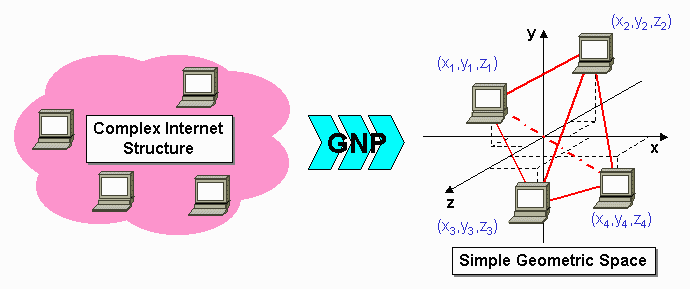| For the layer 3 topology,
Traceroute is a good tool ( if the machine responses well for the ICMP
message). But if you want to find layer 2 topology, traceroute will not
work, since layer 2 is transparent to it.
If you want to find the layer
2 topology you have to use the SNMP, and in the following paper some
ideas were proposed to solve the problem. They all need to get info
from MIB.
Also how to find the hidden
layer 2 switch between the layer 3 device is a good problem, based on
some BW measurement tools, the difference result from 2 different BW
measure methods will provide some useful info about the existence of
layer 2 devices.
- References:
- Topology
Discovery in Heterogeneous IP Networks, Yuri Breitbart, Minos
Garofalakis, Cliff Martin, Rajeev Rastogi, S. Seshadri, Abraham
Silberschatz. Proceedings of IEEE INFOCOM 2000, Tel Aviv, Israel,
March 2000.
- Physical
Topology Discovery for Large Multi-Subnet Networks,Yigal Bejerano,
Yuri Breitbart, Minos Garofalakis, Proceedings of IEEE INFOCOM
'2003.
- Topology
Discovery for Large Ethernet Networks, B. Lowekamp, D. R.
O¡¯Hallaron, and T. R. Gross,Proceedings of ACM SIGCOMM,San Diego,
California, Aug. 2001.
- Octopus
project: Network Topology Discovery at Cornell,Representative
paper: Discovering neternet Topology, R. Siamwalla, R. Sharma
and K. Keshav, Proceedings of IEEE INFOCOM '99.
- Heuristics
for Internet Map Discovery, Ramesh Govindan, Hongsuda Tangmunarunkit,Proceedings
of IEEE INFOCOM 2000, Tel Aviv, Israel, March 2000.
- A
brief explanation for finding the hidden
switch
But if you want to identify
the internal logical topology, only from the
end-to-end measurement, you may need network tomography.
This is a new field which benefit greatly from the wealth of statistical
theory and algorithms. And the topology identification is one promising
application.
- Network
Tomography: recent developments
- Internet
Tomography
- IEEE
INFOCOM 2003 "Traffic Monitoring and Topology Inference"
- Maximum
Likelihood Network Topology Identification from Edge-based Unicast
Measurements.
- Maximum
Likelihood Network Topology Identification from End-to-end Unicast
Measurements. (By using the sandwidth probes, we can get sample
about the queue delay along each link. Then we build the maixmum
likelihood function, and use it to infer the tree topology which
will most likely fit the real topology. And a novel Markov Chain
Monte Carlo procedure was developed for the rapid determination
of the most likely topologies.)
- Network
Tomography and the identification of share infrastructure.
- Discovering
General Logical Network Topologies ( Based on the result from
5 )
|
Given N end hosts, which belong to
different administrative domains, how could we divide them into different
clusers or groups by the network
distance between them without knowing the info about the
underlying topology ?
There are several projects
related to this problem:
- Global
Network Position (GNP)
- The key idea is to represent the
complex structure of the Internet by a simple geometric space
(e.g. an N-dimensional Euclidean space). In this representation,
each host in the Internet is characterized by its position in
the geometric space with a set of geometric coordinates. If the
representation is accurate, then the easily computable geometric
distances between hosts in this geometric space can accurately
approximate the Internet network distances, and no actual network
measurements are required.

- If the number of landmark is D,
then the vector will be D-dimension. And the distances of all
paths between N end hosts can efficiently communicated by K sets
of coordinates of D numbers each (i.e. O(KD) of data), as opposed
to K(K-1)/2 individual distances (i.e., O(K^2) of data).
- As to the network
distance, the metric is round-trip propagation and transmission
delay, a relatively stable characteristic between hosts.
- Internet
Distance Map Service (IDMaps)
- The objective of this
research is to explore scalable design alternatives for an architecture
to provide Internet Distance Maps Service (IDMaps). In IDMaps, special
HOPS servers maintain a virtual topology map of the Internet consisting
of end hosts and special hosts called Tracers.
This virtual topology map is used to predict Internet distance.
For example, the distance between hosts A and B is estimated as
the distance between A and its nearest Tracer T1, plus the distance
between B and its nearest Tracer T2, plus the shortest path distance
from T1 to T2 over the Tracer virtual topology. As the number of
Tracers grow, the prediction accuracy of IDMaps tends to improve.
- Where to put place the
Tracer is an interesting problem.IDMaps
address this in two different ways, namely the K-HST and the minimum
K-center algorithms. These algorithms have been used to determine
placement of fire stations, ambulance placement.
Based on all these related
works, I am going to use the algorithm used in ECO
(Effective Collective Operation) and the
network distance to cluster the hosts. Here,
you can find more about ECO.
- Select the landmark.
I will use the Domain Name Sever(DNS) of each hosts as the landmarks.
But each time a new DNS is added the dimension of the space will
increased by one, then we may need to recaculate all the network
distance again. We should find an optimal solution, that is mean
only add new DNS as the landmark when it is necessary.
- Get the coordinate
of each hosts.
Suppose that there are n hosts ( H(i), where i=1, 2, ...,n) ,
and m landmarks ( L(j), wherej=1,2,3, ... , m).
Cor[H(i)] = { Xi1, Xi2,
..., Xij, ... , Xim}, where Xij=Latency[H(i), L(j)]
- Caculate the network
distance (and the vector similarity) based on the coordinates
D(H(i),H(j)) = sum of
(Xik-Xjk)*(Xik-Xjk), where k=1,2, ... , m
- Use the following
algorithm to cluster the hosts.
|





